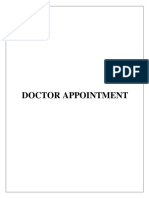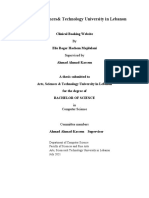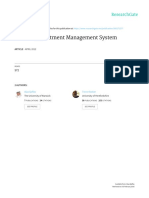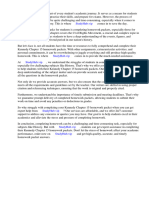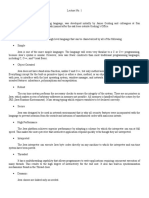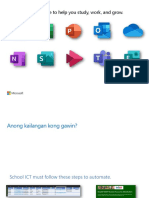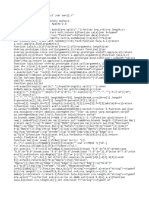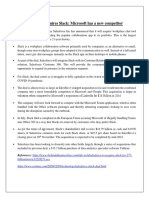Booking Appointment System
Uploaded by
chong samuel sundayBooking Appointment System
Uploaded by
chong samuel sundayCHAPTER ONE
1.0 INTRODUCTION:
In today’s fast-paced corporate environment, the efficient management of time is crucial for
directors and senior executives. The traditional methods of scheduling appointments, often
relying on manual coordination through administrative staff, can be cumbersome and prone
to errors. To address these challenges, organizations increasingly turn to digital solutions that
automate and streamline the appointment booking process.
According to a study by McKinsey & Company, effective time management among
executives can significantly enhance organizational productivity and decision-making
processes (McKinsey, 2021). This underscores the importance of implementing robust
systems that not only facilitate seamless appointment scheduling but also integrate with
existing organizational workflows.
The Director Appointment Booking System (DABS) proposed in this study aims to
revolutionize how appointments are managed within [Organization Name]. By leveraging
modern technologies and best practices in software development, DABS seeks to optimize
director availability, improve communication between stakeholders, and enhance overall
operational efficiency.
According to Zozi, online booking systems bring tour and activity business owners into the
21stcentury and it is defined as making a reservation or appointment for a service via the
Internet. When you pair the technology with old-school customer service, your business gets
an exciting edge for selling services and filling activities. With it, customers can book for
show tickets online and pay via the Internet before hand using debit/credit or master cards,
etc. After an online payment, customer will receive a booking code orserial number which is
1
unique for entry and also a form or ticket with the code on it will be printed by thecustomer.
The ticket will include the passport of the customer for security against theft. In case of loss
ofticket, the customer can go online to request for another one; and this differs a lot from the
traditional booking, which involves long hours queuing for tickets. Some major areas of
application include;
o Hotel for booking rooms
o Cinema houses
o Airport for booking tickets
o Event Organizations for football shows and concert seat reservations
o Bus and train bookings
o Used in making reservations in healthcare
1.2 BACKGROUND OF THE STUDY
Appointment scheduling systems are used by primary and specialty care clinics to manage
access to service providers, as well as by hospitals to schedule elective surgeries. Many
factors affect the performance of appointment systems including arrival and service time
variability, patient and provider preferences, available information technology and the
experience level of the scheduling staff. In addition, a critical bottleneck lays in the
application of Industrial Engineering and Operations Research (IE/OR) techniques. The most
common types of health care delivery systems are described in this article with particular
attention on the factors that make appointment scheduling challenging. For each environment
relevant decisions ranging from a set of rules that guide schedulers to real-time responses to
deviations from plans are described. A road map of the state of the art in the design of
2
appointment management systems is provided and future opportunities for novel applications
of IE/OR models are identified.
Appointment Management system is a desktop application that is designed to help fix
schedule and appointment from the management of organization and the customers, send
messages to customers either by phone or email. With this computerized system there will be
no loss of record or member record which generally happens when a non - computerized
system is used. It is designed in Visual Studio and the database used is Microsoft SQL Server
2005.
In contemporary organizational settings, effective management of director appointments
plays a pivotal role in ensuring smooth operations, strategic decision-making, and efficient
resource utilization. Directors, being key decision-makers, often have damanding schedules
that require precise coordination to mazimize their availability and effectiveness.
Traditional Methods of Appointment Scheduling, such as Manual booking or basic Calendar
tools, frequently fail short in meeting the complexities and demands of modern organizational
structures.
The need for a dedicated Director Appointment Booking System arises from these challenges
and demands. Such a system aims to dtreamline the process of scheduling appoitments,
enhance communication among stakeholders, and optimize the use of director’s time.
1.3 STATEMENT OF THE PROBLEMS
In a dynamic corporate environment, directors and other senior executives often have tight
schedules that necessitate efficient management of their time. Currently, the process of
scheduling appointments with directors involves manual coordination via administrative staff,
3
which can be time-consuming and prone to errors. To streamline this process and enhance
productivity, there is a need to develop a Director Appointment Booking System.
There are problems found in appointment which include:
o An increase in the waiting time for appointments
o Frustration for Students, and staff
o A waste of valuable resources
1.4 OBJECTIVE OF THE STUDY
The objective of this project is to design and implement a web-based Director Appointment
Booking System that automates and simplifies the process of scheduling appointments with
directors. The system aims to provide a user-friendly interface for both directors and users
(employees, clients, etc.) to view director availability, request appointments, and receive
confirmation or rescheduling notifications by the following features:
1. User Roles:
o Directors: Should be able to manage their availability, view appointment
requests, and confirm or reschedule appointments.
o Administrators: Should have access to manage director schedules, view
appointment logs, and generate reports.
o Users (Employees/Clients): Should be able to view director availability,
request appointments, and receive notifications.
2. Appointment Management:
o Allow directors to set their availability (regular hours, exceptions, vacations).
o Enable users to view available time slots, request appointments, and receive
immediate confirmation or rejection based on director availability.
4
3. Notifications:
o Automatic notifications via email or SMS to confirm appointment requests,
reminders before appointments, and notifications for any changes
(cancellations or reschedules).
4. Integration:
o Integration with calendar services (e.g., Google Calendar, Outlook) to
synchronize director schedules and avoid conflicts.
o Single sign-on (SSO) integration for seamless authentication with existing
corporate systems.
5. Security:
o Secure user authentication and authorization mechanisms.
o Data encryption for sensitive information (e.g., appointment details).
6. Reporting:
o Generate reports on appointment statistics (e.g., number of appointments per
director, average response times).
7. Usability:
o Intuitive and responsive user interface that is easy to navigate for all user
roles.
o Accessibility features to accommodate users with disabilities.
it also aim to design and implement N.V.R.I Director Appointment Booking System that can
resolve issue such as:
o To resolve Contact issue.
5
o To Request column for creating new appointment.
o To view appointment list.
1.5 SIGNIFICANCE OF THE STUDY
The significance of this study is to help and give benefits to students, staff and school
management of knowing what appointment booking system is all about and the potential to
address several critical needs and challenges within an organization
the Director Appointment Booking System significantly enhances organizational efficiency,
productivity, and user experience by automating and optimizing the scheduling process. It
fosters better communication, improves resource utilization, and provides valuable insights
for strategic decision-making, thereby contributing to overall organizational effectiveness and
success.
1.6 LIMITATION OF THE STUDY
When developing a Director Appointment Booking System, several limitations and
challenges should be acknowledged to ensure realistic expectations and effective
management throughout the project. DABS promises significant benefits, it is important to
acknowledge potential challenges such as integration complexities with existing IT
infrastructure, user adoption issues requiring adequate training and support, and the need for
robust security measures to protect sensitive data. Addressing these limitations will be critical
to the successful implementation and adoption of Director Appoitment Booking System
within Federal college of Animal Health Production Technology, Vom.
o Unavailability of academic materials.
o Transport problem
6
o Lack of financial support
o Lack of Time
1.7 SCOPE OF THE STUDY
This study will focus on defining the functional and non-functional requirements of DABS,
including appointment scheduling, user roles and permissions, notification systems,
integration with calendar services, security measures, and usability considerations. It will
encompass the design, development, testing, and deployment phases, ensuring alignment with
organizational goals and regulatory compliance. It will also concentrate on creating new
appointment, and Allow directors to manage their availability, view pending appointment
requests, and confirm or reschedule appointments also other details will be viewed for entry
by staff and the student as the case may be, with a case study of UNITECH HOSPITAL.
1.8 ASSUMPTION OF THE STUDY
Users (administrative staff, directors, and other stakeholders) have regular access to internet-
connected devices to use the system effectively. During the process of data collection,
information relating to Appointment Booking System was obtained from the Internet
(www.wikipedia.com/appointment). The information was collected during the course of my
research. Hence, it is assumed that all the data collected are correct and contains no false
information.
1.9 DEFINITION OF TERMS
o UNITECH: Is an abbreviation which stands for University of Technology.
o Appointment:an arrangement to meet someone at a particular time and place. E.g.:
"she made an appointment with my receptionist".
7
o Management: It is the co-ordination of all the resources of an Organization through
the process of planning, Organization, directing and controlling
o System: Physical component of a computer that is used to perform certain task.
o Data: Numbers, Text or image which is in the form suitable forStorage in or
processing by a computer, or incomplete information.
o Information: A meaning full material derived from computer data by organizing it and
interpreting it in a specified way.
o Input: Data entered into a computer for storage or processing.An emergency is a
situation that poses an immediate risk to health, life, property, or environment.
o Output: Information produced from a computer after processing.
o Information System: A set of interrelated components that collect (or retrieve),
process, store and distribute information to support decision making and control in an
organization.
o COMPUTER:-Computer is an electronic device that accepts data as Input, processes
data and gives out information as output to the user.
o SOFWARE:-Software is set of related programs that are designed by the
manufacturer to control the hardware and to enable the computer perform a given
task.
o HARDWARE: - Hardware is a physical part of a computer that can be touched, seen,
feel which are been control by the software to perform a given task.
o DATABASE: - Database is the collection of related data in an organized form.
o PROGRAMMING: - programmingisa set of coded instruction which the computers
understands and obey.
8
o TECHNOLOGY: -Technology is the branch of knowledge that deals with the creation
and use technical and their interrelation with life, society and the environment,
drawing upon such as industrial art, engineering, applied science and pure science.
o Algorithm: A set of logic rules determined during the design phase of a data matching
application. The ‘blueprint’ used to turn logic rules into computer instructions that
detail what step to perform in what order.
o Application: The final combination of software and hardware which performs the
data matching.
o Data matching database: A structured collection of records or data that is stored in a
computer system.
o Data cleansing: The proactive identification and correction of data quality issues
which affect an agency’s ability to effectively use its data.
o Data integrity: The quality of correctness, completeness and complain with the
intention of the creators of the data i.e ‘fit for purpose’.
9
CHAPTER TWO
LITERATURE REVIEW
Naomi et al., [6] developed an automated Ticket Reservation System for the Millennium
Forum. The work incorporated features that aided the process of online booking for visually
impaired customers. Though, the application was designed for customers to reserve theatre
tickets for various shows, but customers may become distracted or tired having to listen
carefully to a long spoken dialogue. In addition, is the difficulties in understanding accents,
for example, Irish accents. Alex, developed a user-friendly online hotel booking web
interface. The work analyzed the primary user interface and usability aspects of the booking
process within hotel websites and also suggested improvements that can be made to many
commonly used business to customers (B2C) booking-process designs. However, the
research was limited in that it has the same level of occupancy in each room. This is a
problem because, in numerous hotels, the rate per room is different depending upon the status
of the room.
Ainin, et al., [8] analyzed e-Ticketing as a new way of making purchase. In their work, they
identified e-ticketing trends among urban communities particularly in Kuala Lumpur, its
usefulness, reliability, security, conveniences and efficiency. They later developed an
application that allows customers to pay for ticketonline. The limitation encountered in this
work however was that the majority of the respondents were highly-educated and have high
10
income status. These characteristics created a bias and constrain to the ability to extrapolate
from the findings.
Maike, et al., [9] developed an integrated urban e-ticketing for public transport and touristic
sites with the aim of combining several modes of transport (e.g. train, bus, car, bike-sharing,
etc) on a single ticket. However, the implementation required great efforts, since many
stakeholders need to agree on standards, overall arrangements, interfaces designs, overall
purpose, and revenue sharing, which is difficult tasks in multi-actor contexts, including
stakeholders in an environment that is already very difficult to govern. Ljubica, et al.,
[10] analyzed online hotel sales strategies with emphasis on web booking. The work was a
detailed study of world achievements in the context of Information Technology (IT)
development in online hotel sales matching empirical findings which consist of the entire
process of designing and setting up rates and sales strategies. It also focused on the sales
strategy needed to boost the web presence of the hotel for their web booking. However, it was
limited in that it was difficult to adjust to today’s world standards, because of outdated
technology, which is due to the economic situation of that time. Stanitov, implemented a
conceptual marketing framework for Online Hotel Reservation System (OHRS) which was a
theoretical framework of online hotel reservation systems’ (OHRS) design. The work
introduced the value model of an OHRS as a central concept in the OHRS’s design process
and elaborates some of the critical marketing decisions in the design process including
orientation of the system (to agents or direct customers), net or commissionable rates, room
inventory, booking additional services, booking limitations, issuing travel and booking
related documents, online payments, market intelligence, customer feedback capabilities and
additional onsite resources. However, the limitation was that though it was a technically
perfect website design it could be catastrophic from a marketing perspective if it does not
provide excellent online customer experience and stimulates bookings. Canada Health,
11
Infowaydeveloped a friendly web application where customers can book appointments with
doctors analyzed consumer health solutions as a way of exploring the value, benefits and
common concerns of e-booking. It discovered that Canadians regularly book vacations
online, use ATMs and conduct a wide variety of tasks over the Internet which previously
required telephone or in-person contact. The work was limited in that it is possible for the
patients to book up the whole schedule of the doctor whereas the doctor has appointment
schedule that he does not want the patients to book online.
CHAPTER THREE
RESEARCH METHODOLOGY
System analysis and design
2.1. Technological design of the system
In designing and implementing this secured system, the design architecture are into three
phases (i.e. The front-end, middle-tier and back-end). These also form the components that
was used in designing the system and these design components include; Web browsers
HTML, CSS and JavaScript for the front end design Web Server (Apache) PHP (A scripting
language) Relational Database System (MySQL) The System is designed to run specifically
on the web apache’s server and all other operating systems that make use of this technology.
The System is platform independent (i.e. it can work on all web browsers) with the use of
XAMP server which is the combination of Apache, PHP and the MySQL database.
12
Figure 2. A technological design of the system
Among the various components of the desired system is the figure 2 above and sketching the
above figure is also represented below The back-end components: It consists of a MySQL
database. This stores all the necessary information about the administrator and users of the
system. The application also allows multiple ticket purchases and as such tables were
designed to have a space for it. All the information concerning the users is stored in the users
table. In this case, the administrator can view the purchases and also validate such purchases.
All the available films and their information are stored in the admin panel table. In this way,
the administrator can add movies, time, day, and banners and so on to the system. In addition,
the movie news table stores up news related to entertainment on the website, this action is
done by the administrator. The available seats are stored up in the available seat table which
makes it possible to indicate when a seat is booked. This (backend) is hidden from view of
regular website visitors because it is the brain of the website that is built with the server side
language (PHP) and database. The front-end components: It interacts with a customer in real
time while back-end code interacts with a server to return customer ready results. Whatever is
displayed on the website is mainly as a result of the query performed on the server and
returned data to the front-end. Hypertext preprocessor (PHP): It is a server side scripting
language (code) in the backend that connects with a database (MySQL) to lookup, save or
change data and return it back to the customer in form of frontend code Code igniter: It is a
PHP Mode View Controller (MVC) Framework that allows developers code up his/her web
13
application with little effort while achieving much simultaneously. The framework is
designed such that the developer can easily configure and manage his/her application files
from a central point.
2.2. Architectural design of the system
Component Architecture: The proposed system is a web application built on client-server
architecture that allows user to get all the relevant information by accessing the site
anywhere, anytime via web browser. The system also consists of two layers, client and server
layers. As shown in figure 3, server interacts with several clients, ranging from from t = 1, 2,
3……..n, at the same time (see figure 3).
Process Architecture As shown in figure 4, the proposed e-booking system has three tiers
which are the front-end, middle tier and back-end. The customer interacts with the system
through the front-end by making requests which is processed through the PHP, which is the
middle tier. The system is executed on a central server and all clients communicate with it. A
client handles customer interface while server handles function and operations of relevant
component. All data are resident on the system server, which has the ability to interact with
several clients at the same time by running several processes concurrently. Some of the
14
processing undertaken includes verification, validations, manipulations, request processing,
etc. Figure 5 also show the system architecture of the proposed system.
Use cases description as shown in figure 6.
Login: After registration, the customer goes through the process of logging in else, access
would be denied. The user logs in with a username and password. The system will verify the
username and password to check its validity before the customer is granted entry upon the
validity of the information provided, else the user is denied access to the system. Search
movies: The customer can search the movies available for viewing in the system. The system
will also display the information of the selected movie by the user. Booking: the system
15
offers a seat reservation system for the user where the user can choose the particular section
or seat where he wants to sit after logging in. Payment for booking: in other to preserve
reservation after booking, the customer pays. Ticket print: the customer prints ticket after
payment. Register: If a customer is new, he is mandated to register. If he wants to gain access
to the system. The customer supplies some basic information in the registration page. This is
mainly to know the number of customers using the system. Session editing: the administrator
can edit the session any time of the day. Cinema editing: the administrator can also edit the
cinema any time of the day,
4. Conclusion
This project implements an online booking system for cinema houses mainly in Nigeria. It
can be said
with full assurance that if the system is fully implemented, all the advantages of an online
booking system,
such as, time saving, 24-hour working service, access to the service from anywhere in the
world, availability
check and instant, collecting all guest payments (i.e. using your own merchant
account/payment gateway),
and much more will be achieved.
Furthermore, the full implementation of this project will further improve the booking system
of
16
Nigerian cinemas, even in other areas of life where reservations or bookings are done, and
could also revive
the dying movie watching in cinemas, while also helping to cut down cost of servicing extra
manpower
needed to run report sorting.
Constraints:
Timeframe: The system should be developed and deployed within a specified
timeframe to meet organizational needs.
Budget: Develop within allocated budgetary constraints, considering costs for
development, integration, and maintenance.
Reference:
McKinsey & Company. (2021). Time management: A key to effective leadership. Retrieved
from https://www.mckinsey.com
17
You might also like
- Database Systems Design Implementation and Management 12th Edition Coronel Solutions Manual download pdf100% (4)Database Systems Design Implementation and Management 12th Edition Coronel Solutions Manual download pdf52 pages
- Final Year Project: Doctor Appointment Booking System: Project ID: FYP1-F19-E1480% (5)Final Year Project: Doctor Appointment Booking System: Project ID: FYP1-F19-E1426 pages
- Doctor Appointment System Capstone Project Proposal0% (1)Doctor Appointment System Capstone Project Proposal3 pages
- Step by Step Tutorials For Assembly Programming Using DosBox and MASM0% (1)Step by Step Tutorials For Assembly Programming Using DosBox and MASM1 page
- Design and Implementation of Appointment Booking SystemNo ratings yetDesign and Implementation of Appointment Booking System29 pages
- Major Project Work Presentation: Bachelor of Computer Science and ApplicationsNo ratings yetMajor Project Work Presentation: Bachelor of Computer Science and Applications12 pages
- (A CASE STUDY OF FARAZY HOSPITAL LTD, ABUJA)No ratings yet(A CASE STUDY OF FARAZY HOSPITAL LTD, ABUJA)50 pages
- Benefits Realisation Management: The Benefit Manager's Desktop Step-by-Step GuideFrom EverandBenefits Realisation Management: The Benefit Manager's Desktop Step-by-Step GuideNo ratings yet
- Task Sheet 2.1. Write the Chapter 2. Review of Related Literature,Studies,SystemsNo ratings yetTask Sheet 2.1. Write the Chapter 2. Review of Related Literature,Studies,Systems4 pages
- Development of Patient Information System With Appointment Reservation and Billing System For Jubay Dental ClinicNo ratings yetDevelopment of Patient Information System With Appointment Reservation and Billing System For Jubay Dental Clinic39 pages
- Smart Appointment Generation For Patient: International Journal of Advance Engineering and Research DevelopmentNo ratings yetSmart Appointment Generation For Patient: International Journal of Advance Engineering and Research Development3 pages
- Biometrics Fingerprint Attendance Management: Increase Accountability and Security in Your WorkplaceFrom EverandBiometrics Fingerprint Attendance Management: Increase Accountability and Security in Your WorkplaceNo ratings yet
- 607811964-PROJECT-REPORT-ON-E-DENTAL-CARENo ratings yet607811964-PROJECT-REPORT-ON-E-DENTAL-CARE63 pages
- Online Appointment System in PSU Asingan CampusNo ratings yetOnline Appointment System in PSU Asingan Campus19 pages
- Arts, Sciences& Technology University in Lebanon: Clinical Booking WebsiteNo ratings yetArts, Sciences& Technology University in Lebanon: Clinical Booking Website25 pages
- Digital Queue Management and Appointment Booking System With SMS AlertsNo ratings yetDigital Queue Management and Appointment Booking System With SMS Alerts4 pages
- Web Based Appointment Management System For Out Patient Department Bukidnon Provincial Hospital Kibawe Bukidnon RRLNo ratings yetWeb Based Appointment Management System For Out Patient Department Bukidnon Provincial Hospital Kibawe Bukidnon RRL4 pages
- Report Dental Booking Appointment System PDFNo ratings yetReport Dental Booking Appointment System PDF42 pages
- The Design of An Intelligent Healthcare Chatbot For Managing Ante-Natal RecommendationsNo ratings yetThe Design of An Intelligent Healthcare Chatbot For Managing Ante-Natal Recommendations6 pages
- INCOME TAX Calculation System Project Report-MANU SIWACHNo ratings yetINCOME TAX Calculation System Project Report-MANU SIWACH34 pages
- CSR KC: Whirlwind Tour of Python Mukesh Kumar & Sandeep S GhugreNo ratings yetCSR KC: Whirlwind Tour of Python Mukesh Kumar & Sandeep S Ghugre62 pages
- Variables, Datatypes and TypeconversionNo ratings yetVariables, Datatypes and Typeconversion36 pages
- Libra Office All Shortcut Calc & Writer & ImpressNo ratings yetLibra Office All Shortcut Calc & Writer & Impress6 pages
- Ict Its4 09 0811 Monitor and Administer Database100% (8)Ict Its4 09 0811 Monitor and Administer Database24 pages
- SW Project Planning-Cost Estimation-Risk (2) .No ratings yetSW Project Planning-Cost Estimation-Risk (2) .114 pages
- Cloud Deployment Models - Public, Private and HybridNo ratings yetCloud Deployment Models - Public, Private and Hybrid21 pages
- How To Install ADB On Windows, macOS, and LinuxNo ratings yetHow To Install ADB On Windows, macOS, and Linux1 page
- Fortra_Data_Classification_Suite_for_Windows_Vera_Integration_GuideNo ratings yetFortra_Data_Classification_Suite_for_Windows_Vera_Integration_Guide15 pages
- Mobile Phone Bus Time App: by Brendan HegartyNo ratings yetMobile Phone Bus Time App: by Brendan Hegarty34 pages














